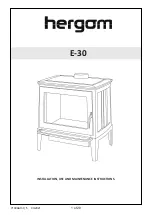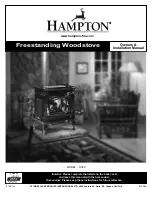
5 of 20
3 - USING THE STOVE
Once your stove has been installed and connected
to the chimney, you are ready to light the fire.
Although your stove is easy to use, the combus�on
process of solid fuels is complicated, as it involves
several factors and it takes �me and experience to
understand the process.
Before ligh�ng your stove for the first �me, please
take time to become familiar with the different
control systems and parts of the unit, how to
choose the wood, how to light it and use it on a
daily basis.
ALWAYS KEEP IN MIND that the stove generates
heat and, therefore, keep children, clothing,
furniture... at a distance to prevent burns from
direct contact with the appliance.
Below, we have included some advice on your
stove and on its use. Please read with care.
Door handle
To open the door, turn the handle upward to the
open posi�on, and gently pull.
The door can open up to 180º
To close, turn the knob to the open position, close
the door, press slightly and turn the handle gently
down to the closed posi�on (Fig. 3).
Ligh�ng up valve
Fully open the valve when ligh�ng the stove (Fig. 3)
Adjustment - Glass Cleaning Valve
Fully open the glass pane cleaning air valve when
ligh�ng the stove.
Once an ideal combustion rate has been achieved,
adjust the vale to prevent excessive air intake,
which will cause excessive combustion levels and
temperatures.
The intermediate position is usually the ideal
adjustment, depending on the quality of the draw
of the chimney installed and on the type of fuel
being used (hard or so� wood) (Fig. 3).
Ash pan
Very important!
Only handle the ash pan when the stove is cold.
Always avoid opening the ash-pan if your stove is
in operation.
To clean the ash, lift the blind grill located at the
bo�om of the stove.
Use a tool (brush) to sweep the ash into the
ash-pan.
The ash-pan is removed from under the stove tray
(Fig. 4).
To remove the ash-pan from its position, pull the
handle gently to release it. Once you have emp�ed
the ashes, return the ash pan to the ash drawer,
pushing it into place to create a seal.
Do not forget to replace the cover in the bo�om of
the fire box.
FIG. 3
OPEN
CLOSE
OPEN
OPEN
CLOSE
CLOSE
FIG. 4






































